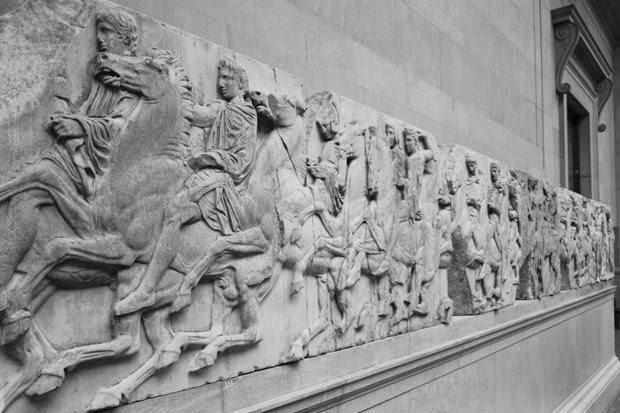
Now that Brexit has finally been accomplished — the United Kingdom formally left
the European Union on January 31 — Britain and its former continental partners are
gearing up to negotiate new terms for doing business with each other. At least one
of those partners, Greece, isn’t only looking ahead, it is also looking back. More than
two centuries have elapsed since a British diplomat —- Thomas Bruce, the seventh
Earl of Elgin — vandalized the Parthenon, looted many of its sculptures, and shipped
them off to England. Lord Elgin eventually sold the carvings to the British Museum,
where they have long been prominently displayed. But Greeks have never ceased
resenting the theft, and intend to use the impending trade talks as leverage to secure
the marble treasures’ return.
At Greece’s request, the latest draft of the negotiating mandate being circulated
among European governments includes a clause that could turn up the heat on Britain
to restore the Parthenon sculptures to their rightful home. The draft language calls
for “the return or restitution of unlawfully removed cultural objects to their country
of origin.” While it doesn’t mention the two-and-a-half thousand year old marbles
specifically, it clearly sets the groundwork for renewing pressure on London to
rectify, at long last, one of history’s most notorious cases of cultural theft.
The British Museum has always denied that Elgin’s removal of the Parthenon
marbles was unlawful. Hartwig Fischer, the museum’s director, said in a BBC radio
interview that the sculptures were brought to Britain “with the explicit permission
of the Ottoman empire, the government in place back then” and that it “was not a
burglaries case.” So Elgin maintained at the time. But even taking his claim at face
value, he was authorized only to “take away some pieces of stone with old
inscriptions and figures” — not to wreak havoc on one of the most splendid triumphs
of Greek antiquity. Elgin helped himself, not to “some pieces of stone,” but to 17
statues, 247 feet of the original Parthenon frieze, and 15 of the great sculpted plaques
known as metopes — square carved slabs of Pentelic marble originally located above
the Parthenon’s columns.
And in fact there were compelling reasons not to take the earl’s claim at face value.
He never produced the Turkish firman, or edict, that supposedly authorized his
seizure, and no one has ever been able to find a copy of it in the Ottoman archives.
Elgin’s only evidence that he had been authorized to deface the Parthenon was a
document written in Italian, which he claimed was a translation of the firman given
to him by the Turkish sultan. Scholars have long cast doubt on the veracity of that
Italian “translation.”
There is even evidence that the document was fraudulently altered by the
British Parliament when it investigated — and ultimately upheld — Elgin’s
claim.
The Parthenon is the foremost monument of Classical Greece. It was
constructed during the era when the city-state of Athens was led by Pericles,
at the very zenith of the Athenian golden age. If anything symbolizes “the
glory that was Greece,” the Parthenon does. And if anything about the Elgin
Marbles is more offensive than the theft itself, it is the notion, promoted by
British chauvinists to this day, that Elgin did the Greeks a favor when he
hauled away great chunks of their great architectural treasure, since they
were too primitive to appreciate what they had.
Making this point in an essay some years ago, I began not by describing
Elgin’s ravaging of the Parthenon starting in 1801, but with an episode during
the Greek Revolution two decades later:
The year is 1821. Greeks are fighting for their independence. In Athens, they
besiege the Acropolis, a stronghold of the Turkish occupiers. As the siege
grinds on, the Turks’ ammunition runs short. They begin to dismantle sections
of the Parthenon, prying out the 2,300-year-old lead clamps and melting them
down for bullets. The Greek fighters, horrified at this defacement of their
patrimony, send the Turks a supply of bullets. Better to arm their foes, they
decide, than to let the ancient temple come to harm.
It is an extraordinary and unexampled gesture of self-sacrifice. But then, the
Parthenon is an extraordinary and unexampled masterpiece of Western
culture. Built in the 5th century BCE as a shrine to Athena, goddess of war
and patron of Athens, it is the acme of classical Greek architecture and
sculpture, the greatest monument of the Age of Pericles. There is no more
storied building in all of Europe. No Greek could see it vandalized and fail to
protest.
And yet by 1821 just such a slander — that the ransacking of the Parthenon
would leave Greeks unfazed — is already in circulation.
Five years earlier and 2,000 miles away, a committee of the British
Parliament had conducted hearings on the huge collection of sculptures and
bas-reliefs that Robert Bruce, the seventh Earl of Elgin, had removed from
the Parthenon and shipped to England. These . . . were being offered for sale
to the British Museum, and there were questions about how Elgin, former
ambassador to the Ottoman Empire, had acquired them.
When the marbles were carried off, one committee member asked Elgin’s
deputy, Philip Hunt, “was any opposition shown by any class of the natives?”
“None,” Hunt replied, and for 180 years that lie has endured. In taking what
he took, the argument goes, Elgin performed a great service — he saved the
sculptures from indifferent Greeks and primitive Turks who didn’t appreciate
them and wouldn’t have given them the care they required.
But no Greek or Turk — or Roman or Crusader, for that matter — ever treated
the Parthenon as brutally as Elgin and his minions did.
The travel writer Edward Daniel Clarke happened to be on the Acropolis one
day in September 1802, when Elgin’s men detached a large sculpted metope
from the temple’s outer frieze.
“One of the workmen came to inform Don Battista” — Giovanni Battista
Lusieri, the painter Elgin had hired to oversee the plundering of the sculptures
— “that they were then going to lower one of the metopes. We saw this fine
piece of sculpture raised from its station between the triglyphs; but . . . a part
of the adjoining masonry was loosened by the machinery; and down came the
fine masses of Pentelican marble, scattering their white fragments with
thundering noise among the ruins.”
When the Turkish military governor in charge of the Acropolis saw what Elgin’s
men were doing, Clarke wrote, he wept. But Elgin’s overseer, Lusieri, had a very
different reaction.
“I have, my lord, the pleasure of announcing to you the possession of the 8th metope,
that one where there is the Centaur carrying off the woman,” he wrote to the earl.
“This piece has caused much trouble in all respects, and I have even been obliged to
be a little barbarous.”
Between 1801 and 1804, Britain’s Lord Elgin removed 17 statues, 247 feet of the original Parthenon frieze,
and 15 of the elegant sculpted metopes from the Parthenon, and transported them to London, where they
have remained ever since.
Barbarous indeed. Elgin’s assault on the Parthenon was driven not by any desire to
preserve great art but by greed: He originally intended the marbles to decorate his
own estate in Scotland. And there was nothing subtle about his methods. His crew
used hacksaws to wrench dozens of metopes and sculptures from the edifice they
had adorned for 23 centuries. Parliament retroactively whitewashed the theft and the
British Museum has been flaunting Elgin’s booty ever since, but conscientious
Britons have long lamented their nation’s role in this cultural felony.
Lord Byron, a passionate philhellene, raged against Elgin. The ambassador’s crime,
he fumed in his great poem “Childe Harold’s Pilgrimage,” was
To rive what Goth, and Turk, and Time hath spar’d:
Cold as the crags upon his native coast,
His mind as barren and his heart as hard,
Is he whose head conceiv’d, whose hand prepar’d,
Aught to displace Athena’s poor remains.
What was equally outrageous, Byron wrote, was for the Parthenon’s sculptures to be
imprisoned so far from the site for which they were created. He bewailed the removal
of the treasures from their home:
Dull is the eye that will not weep to see
Thy walls defaced, thy mouldering shrines removed
By British hands. . . .
It is long past time to set right an old wrong and return these works to their birthplace.
“Understand what the Parthenon Marbles mean to us,” the late Melina Mercouri, the
renowned actress who became Greece’s minister of culture, pleaded in 1986. “They
are our pride. They are our sacrifice. They are our noblest symbol of excellence.
They are a tribute to the democratic philosophy. . . . They are the essence of
Greekness.”
For more than two centuries, the “essence of Greekness” has been trapped far from
Greece. Britain can never fully repair the damage caused by Lord Elgin. But can it
not, at long last, let the abducted exiles return home?
